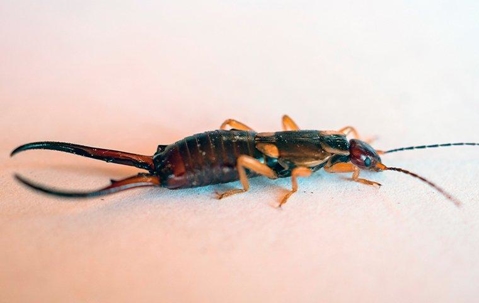Pretty much everybody knows an earwig when you see one; however, most people call them pincher bugs. They are among the most common insects in the garden, returning faithfully each year to do what earwigs do. You know, eat your sapling plants and soft fruits, or maybe destroy your corn crop. The team at Pro-Active Pest Control knows just what it takes to get rid of your earwig problem with our effective pest control services in Mesa.
What Do Earwigs Do In Your Ear?
Is there any truth to the unsettling notion of an earwig venturing into your ear? The name alone suggests a sinister origin story. Centuries ago, folk beliefs circulated, suggesting that these eerie insects might stealthily invade your ear as you slumbered, feasting on your thoughts and ultimately laying their eggs within the confines of your ear canal. Ew!
Luckily, that isn't the case: it's simply an old wives' tale. Earwigs in Mesa are no more likely to enter your ear than any other bug. However, that doesn't mean it's impossible for them to crawl into your ear. In fact, there are several documented cases of different insects doing just that. But it's not likely to happen and not something you should worry about, even if you have been seeing earwigs around your property.
Are Earwigs Dangerous?
To answer this common question: no, earwigs pose no real threat to humans. They lack stingers, fangs, or any venomous capabilities they could use to cause harm to humans or pets. Despite their formidable-looking pincers, they're unable to inflict actual harm upon us; at most, they might give a minor pinch that can't break the skin or cause pain.
However, they can be a danger to other insects or even fellow earwigs; they have a distinctive appetite for pests like aphids, which actually makes them allies in the eyes of most gardeners. So, rest assured, those eerie earwigs won't be causing you any trouble and, in certain cases, can even be considered a benefit to your garden. However, once again, their overall beneficial nature doesn't mean much if their extensive activity is causing you discomfort.
How Did An Earwig Get Into My Bed?
Earwigs typically prefer outdoor habitats, such as hiding beneath rocks or burrowing into soil, but occasionally, they venture indoors. Here are some of the primary motivations behind their visits to the Mesa area:
- Food: Like any other living organism, earwigs seek sustenance. If your home hosts smaller insects that they can feed on, you may find them paying you a visit.
- Water: Earwigs have a fondness for damp and humid environments. If your basement or crawl space tends to be moist, expect some earwig guests.
- Shelter: Finally, earwigs need a comfy place to live, just like anything else. In this case, they specifically look for warmth. Unfortunately, your body heat can be enough to attract them to places like your bed on a chilly night.
- Light: It might seem counterintuitive for creatures that dwell under rocks, but earwigs can be oddly attracted to light sources. This is partly why they are often seen crawling around bathrooms, kitchens, and other well-lit areas at night.
If you've started seeing earwigs around your home, it's time to start thinking about ways you can rid yourself of these meddlesome pests.
How Do You Kill An Earwig?
Numerous DIY and natural approaches have proven effective, though it's important to remember that nature's resilience can sometimes defy our efforts.
- Rubbing Alcohol: Mixing equal parts of rubbing alcohol and water in a spray bottle is a practical method. This concoction disrupts the earwig's protective waxy layer, swiftly dispatching them upon contact. It's surprisingly effective.
- Diatomaceous Earth: Sprinkle diatomaceous earth in your flower beds, as it acts by dehydrating earwigs as they crawl over it.
- Natural Predators: Birds and toads, natural enemies of earwigs, can devour up to 100 of them in a day. Cultivating a garden that attracts these helpful creatures not only keeps earwigs in check but also addresses other pest issues.
During exceptionally rainy years, you can anticipate an increase in earwig populations. To counter this, consider removing moisture-retaining gardening products like mulch, pine needles, or bark from close proximity to your house.
For the most effective and reliable earwig control, it's advisable to enlist professional home pest control services. Pro-Active Pest Control boasts years of experience in eradicating a wide array of pests, including those unsettling earwigs. Contact us today for a complimentary estimate and to learn more about our residential and commercial pest control services in Mesa.

